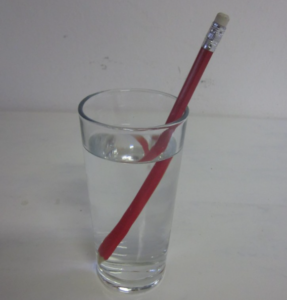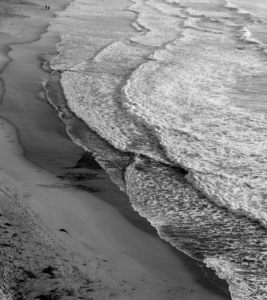The physical phenomenon of bending of waves is known as wave refraction. The refraction of waves examples are given below.
- Refraction in sound waves
- Refraction in light waves
- Refraction in water waves
- Refraction in radio waves
Refraction in sound waves
The deflection observe in the path of a sound wave because of a change in medium is known as refraction of sound waves. Now let us understand sound wave refraction with the help of an example.
A natural example of sound wave refraction is a difference in the atmosphere’s temperature around us. As we all know, the source of energy for the earth is the sun. When heat rays fall on earth, it heats the earth’s surface. Along with heating the earth’s surface, the air mass above it is also heated.
As we know, the air mass is heated, which means its particle is moving faster. So it will rise, now on farther with the heat source the air will relax. So as the air mass keeps on rising, the air at the top keeps on cooling. This creates an adiabatic lapse rate. As we observe here, the warm air is close to the earth.
Because of this, the sound wave will travel faster near the earth’s surface. Because sound waves travel faster In a warm medium. This high speed of the sound wave in a warm atmosphere near the earth’s surface creates Huygens’ wavelets, which spread faster near the earth’s surface.
Under conditions like the movement of sound waves in a perpendicular direction to the wavefront formed by the Huygen wavelets, the sound gets refracted upward, and it has vanished.
Refraction in light waves
When it passes through a homogeneous medium, a light wave passes straight without any hindrance or change. The change in density of a medium followed by change in medium causes refraction.
While moving through a rarer medium to a denser medium, the refraction of light wave is seen. While moving in such case it deflects more towards normal. In contrast, when the light wave travels from a denser medium to an optically rarer medium, it bends away from the normal. However, if the light wave falls perpendicular to the normal, it passes without deflections.
For the Refraction of light waves, two laws are followed. Firstly, the incident, refracted, and normal all lie on the same plane. And secondly, the ratio of the sine of incident angle and the sine of a refracted angle in a given medium remains the same.

Image Credits: “Refraction of light” Siyavula Education CC BY 2.0
As we know due to different density of particle, being unique, the light’s speed also changes, which causes refraction. So whenever there is a change in the velocity of light, it goes through bending of the wave.
We all have seen the Refraction of light in our daily life many times. For example, Refraction in our eyes lenses, Refraction in ice, flattening of the sun at sunrise and sunset, Refraction in water drops, an apparent shift in the position at sunrise all occur due to Refraction of light.
Refraction in water waves
The Refraction of water waves depends upon the medium and the density it travels. The Refraction causes a change in the speed of water waves.
To understand the Refraction of water waves. First, let us understand some properties of water moving in oceans. The velocity of the water waves which are on the top is majorly defined by the depth of it. Water having a depth are have fast velocities.so if water which are at depth when meet the water of shallow depth there velocity decreases.
The decrease in the speed of water waves is followed by a decrease in their wavelength. Hence, this shows that when water waves from deep water and shallow water meets then their velocities decrease, their wavelength reduces, and consequently, its direction of motion changes too.

There is a change in medium on moving deeper water to shallow water. This happens because deeper water is cold and dense. After all, sunlight does not reach it. And hence no heat. While the shallow water is comparatively warmer because it faces sunlight to some extent, and hence it is less dense.
The waves that come from deep and shallow waters can be seen refracting, which means the waves slightly bend, their wavelength changes, and their speed is slowed down.
Refraction in radio waves
In our daily life, we all have heard the radio. These radios are operated by the radio waves transmitted. Let us understand how these radio waves reach all-around to operate radios.
The Radio waves are refracted in the uppermost layer of our atmosphere, which is the ionosphere. As it is the outermost layer of our atmosphere, it consists of a large number of free ions and electrons in it. This is due to the extreme amount of heat received by the sun, which ionizes all particles present there.
When the radio waves reach the ionosphere, the electrons present in the ionosphere get excited, which causes their motion. Due to this the radio waves are emitted again. Now as discussed above the concentration of free ions and electrons is high in this layer of atmosphere. When the radio waves further move due to excitement caused by free electrons, it faces a region of a very high density of electrons.
This high-density region reflects the radio waves back to earth. And that is how the radio wave is transmitted all-around a region. However, this reflection of radio waves depends upon the angle of incidence as well as the frequency of the radio waves. The Refraction, which occurs in the ionosphere due to inappropriate angle of incidence, tends to reduce when the frequency of the signals is improved.
Because of this, the Refraction is turn down, and reflection of radio waves starts in the outermost layer. As we know, the ionosphere is ionized, and moving particles are there. So the density does not remain the same all around; it varies. So the amount of Refraction varies.
Also Read:
- Amplitude of a wave
- Does amplitude increase in a wave
- Does longitudinal wave travel
- How to find energy of a photon from wavelength
- How to find the frequency of a wave
- Does amplitude of wave change
- How to find frequency of transverse wave
- Does wavelength affect diffraction
- How to measure energy in a gravitational wave detector
- Why does light exhibit both wave and particle characteristics
I am Riya Pandey. I have completed Post Graduation in physics in 2021. Currently I am working as a Subject Matter Expert in Physics for Lambdageeks. I try to explain Physics subject easily understandable in simple way.